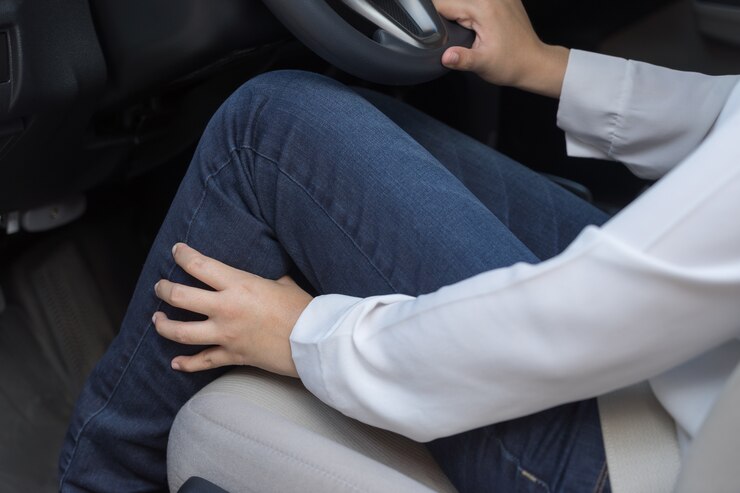How to stop knee pain when driving

Driving is a routine part of many people’s lives, whether commuting to work, running errands, or embarking on road trips. However, for some individuals, this seemingly ordinary activity can become a source of discomfort and pain, particularly in the knees. Knee pain while driving is a common issue that can significantly impact driving performance and overall comfort behind the wheel. This article will explore various strategies and techniques to alleviate and prevent knee pain while driving, enabling you to enjoy a pain-free and comfortable driving experience.
1. Introduction: Understanding the Problem of Knee Pain while Driving
1.1 The Prevalence of Knee Pain among Drivers
Knee pain while driving is a common issue that many people experience. Whether you’re a daily commuter or embarking on a long road trip, the hours spent behind the wheel can take a toll on your knees.
1.2 Impact of Knee Pain on Driving Performance and Comfort
Not only can knee pain be a nuisance, but it can also significantly impact your driving performance and overall comfort. When your knees are throbbing or stiff, it’s challenging to maintain focus and react quickly on the road. The discomfort can make even the shortest drive feel like a never-ending journey. So, addressing this issue and finding ways to alleviate knee pain while driving is crucial.
2. Ergonomic Considerations: Optimizing your Driving Posture
2.1 Importance of Proper Seat Adjustment
One of the critical factors in preventing knee pain while driving is optimizing your driving posture. Adjust your seat to ensure proper support for your back and thighs. Make sure your knees are at a comfortable angle, neither too bent nor too straight. It would help if you had a slight bend in your knees, and your feet should comfortably reach the pedals without overstretching.
2.2 Adjusting the Steering Wheel and Pedals for Comfort
In addition to seat adjustment, it’s essential to customize the steering wheel’s position and pedals for optimal comfort. The steering wheel should be positioned to allow your arms to rest comfortably while maintaining a slight bend in your elbows. Similarly, adjust the pedals so your feet can easily reach them without straining your knees or ankles.
2.3 Utilizing Lumba and Knee Supports
To further enhance your driving comfort, consider using lumbar and knee supports. Lumbar supports provide extra cushioning and help maintain the natural curve of your lower back, reducing stress on your spine. Knee supports, such as cushions or braces, can provide added stability and reduce strain on knee joints during long drives.
3. Strengthening Exercises: Building Stability and Flexibility in the Knee
3.1 Quadricep Strengthening Exercises
Building strength in your quadriceps can help stabilize your knee joints and reduce pain. Exercises like squats, lunges, and leg extensions target the quadriceps muscles. Start with lower weights and gradually increase as your strength improves. Remember, quality over quantity – focus on proper form to avoid unnecessary strain.
3.2 Hamstring Strengthening Exercises
Strong hamstrings are essential for maintaining knee stability. Incorporate exercises like hamstring curls, deadlifts, and bridges into your routine. Just like with quadriceps exercises, start with lighter weights and gradually progress. Strong hamstrings will provide better support for your knees and reduce discomfort while driving.
3.3 Calf Strengthening Exercises
Please pay attention to your calf muscles regarding knee pain prevention. Strengthening your calves can improve overall stability and support in your lower body. Exercises like calf raises and ankle flexion/extension can effectively target these muscles. Be sure to perform these exercises slowly and with control to avoid unnecessary strain.
4. Stretching Techniques: Promoting Mobility and Minimizing Pain
4.1 Dynamic Warm-up Stretches
Before hitting the road, you must warm up your muscles with dynamic stretches. Dynamic stretches involve moving parts of your body through a controlled range of motion. Try exercises like leg swings, hip circles, and knee circles to loosen up your joints and increase blood flow to the area.
4.2 Static Stretches for the Quadriceps and Hamstrings
Incorporate static stretches after your drive or during breaks to maintain mobility and minimize knee pain. Stretching the quadriceps and hamstrings can help relieve tension in these muscle groups. Simple stretches like the standing quad stretch or seated hamstring stretch can be quickly done in the car or during a rest stop.
4.3 Calf and Hip Flexor Stretches
Remember to stretch your calves and hip flexors to alleviate knee pain. Tightness in these areas can contribute to knee discomfort. Stretching exercises like calf stretches and kneeling hip flexor stretches can help relieve tension and improve flexibility. Take a few moments during your breaks to perform these stretches and keep your knees happy.
Remember, everyone’s body is unique, and listening to yours is essential. If you experience persistent or severe knee pain while driving, it’s best to consult with a healthcare professional. By following these ergonomic considerations, performing strengthening exercises, and incorporating stretching techniques, you’ll be well on your way to a more comfortable and pain-free driving experience. So, buckle up, adjust those mirrors, and hit the road with happy knees! Management Routine for a Comfortable Driving Experience
5. Pain Management Strategies: Over-the-Counter and Home Remedies
Driving with knee pain can be a real pain in the…well, knee. But fear not; there are ways to manage and even alleviate that discomfort without extreme measures.
5.1 Using Ice or Heat Therapy
This one’s a classic. Applying ice or heat to your achy knee can provide some much-needed relief, like when you stub your toe and instinctively reach for a bag of frozen peas. Cold therapy helps reduce inflammation and numb the pain, while heat therapy relaxes muscles and improves blood flow. So go ahead, grab an ice pack or a heating pad and enjoy the soothing sensation.
5.2 Topical Analgesics and Pain Relievers
If you do not like playing the waiting game, topical analgesics and pain relievers can be your best buds. There are plenty of creams, gels, and patches available over the counter that can provide temporary relief by numbing the pain. Just make sure to read the instructions and use them as directed. Oh, and remember to wash your hands after applying. Trust us, you don’t want that menthol sensation anywhere near your eyes.
5.3 Incorporating Anti-inflammatory Foods and Supplements
They say, “You are what you eat,” and while that may not make you a knee expert, it does mean that certain foods can help reduce inflammation in your body. Incorporate fatty fish, nuts, berries, and leafy greens into your diet to give your knees some extra love. Supplements like omega-3 fatty acids and turmeric can also work their magic in reducing inflammation. So, whip up a delicious salmon salad and sprinkle some turmeric on top for a knee-friendly meal.
6. Lifestyle Modifications: Making Healthy Choices for Long-Distance Driving
Driving long distances can be a real adventure, but it can become a painful ordeal if your knees aren’t up for the challenge. To avoid that pitfall, some lifestyle modifications can make your driving experience much more enjoyable.
6.1 Taking Regular Breaks and Stretching
Let’s face it: even the most comfortable car seats can turn into torture chambers after a few hours. That’s why taking regular breaks and giving your knees some stretching love is crucial. Get out of your car, walk around, and perform simple knee stretches to loosen up those stiff joints. Your knees will thank you, and you’ll be ready to conquer the road again.
6.2 Maintaining a Healthy Body Weight
Carrying extra weight can strain your knees unnecessarily, making them more prone to pain and discomfort. So, maintaining a healthy body weight is good for your overall health and lightens the load on your knees. Eat a balanced diet, stay active, and shed those extra pounds if necessary. Your knees will appreciate the extra breathing room.
6.3 Importance of Hydration and Proper Nutrition
No, we’re not trying to nag you like your mom. But seriously, keeping yourself hydrated is vital for a smooth sailing driving experience. Proper hydration helps lubricate your joints and prevent stiffness. And while you’re at it, fuel your body with nutritious snacks and meals to keep your knees happy and your energy levels up.
7.Seeking Professional Help: Consulting a Healthcare Provider for Chronic Knee Pain
When knee pain becomes a constant companion on your driving adventures, it’s time to bring in the professionals. Here’s when seeking medical advice can be a game-changer.
7.1 When to Seek Medical Advice
If your knee pain persists or worsens despite trying various pain management strategies, it’s time to pick up the phone and schedule an appointment with a healthcare provider. They can evaluate your condition, diagnose underlying issues, and recommend appropriate treatment options.
7.2 Diagnosing and Treating Underlying Conditions
Sometimes, knee pain can be a symptom of a more significant problem, like arthritis or an injury. A healthcare provider can conduct tests, such as X-rays or MRI scans, to determine the root cause of your pain. Once the underlying condition is identified, they can suggest appropriate treatment options, such as medication or physical therapy.
7.3 Physical Therapy and Rehabilitation Options
Physical therapy is not just for Olympic athletes or dancing hippos in Disney movies. It’s a valuable tool in managing and rehabilitating knee pain. A physical therapist can design a personalized exercise program to strengthen your knee muscles, improve flexibility, and reduce pain. They can also teach proper body mechanics and techniques to protect your knees during daily activities, including driving.
8. Maintaining a Pain Management Routine for a Comfortable Driving Experience
Nobody wants to endure knee pain while driving, especially when so many tools and strategies are available to alleviate the discomfort. You can maintain a pain-free routine and enjoy the open road without knee-related speed bumps by implementing pain management strategies, making healthy lifestyle choices, and seeking professional help.
8.1 Implementing the Strategies That Work Best for You
Remember, every knee is unique, just like every snowflake or that one quirky aunt. So, experiment with different strategies and find what works best for you. It may take some trial and error, but your knees will praise you once you find the winning combination.
8.2 Enjoying the Journey Without Knee Pain
Life is too short to let knee pain damper your driving adventures. So, take charge of your pain management routine and hit the road without hesitation. Whether it’s a cross-country road trip or a daily commute, make it a journey to remember, not a knee-punishing ordeal.
8.3 Remembering to Drive Responsibly and Safely
Last but certainly not least, while we’re all about knee pain relief, we’re also all about safety. So, stay focused on the road, follow traffic rules, and don’t let your knee pain management routine distract you. After all, the ultimate goal is to arrive safely at your destination, knees intact.
Conclusion:
As discussed in this article, you can effectively address and alleviate knee pain while driving by implementing ergonomic considerations, strengthening exercises, stretching techniques, pain management strategies, lifestyle modifications, and seeking professional help. Remember, taking proactive steps to optimize your driving posture, build knee strength and flexibility, manage pain, and make healthy choices will enhance your driving experience and contribute to your overall well-being. Prioritize your comfort and care for your knees to ensure a pain-free and enjoyable time on the road. Safe travels!
FAQ
-
Can driving posture affect knee pain while causing it?
Yes, driving posture is crucial in determining the amount of stress and strain placed on your knees. Incorrect posture can lead to misalignment of the joints, increased pressure on the knee, and ultimately result in pain and discomfort. By optimizing your driving posture and making necessary adjustments, you can significantly reduce knee pain while driving.
-
How long should I take breaks while driving to alleviate knee pain?
Regular breaks during long drives are essential to prevent and alleviate knee pain. Experts recommend taking breaks every 1-2 hours or whenever you start experiencing discomfort. Use these breaks to stretch your legs, perform simple exercises, and allow your knees to rest and recover.
-
Are there any specific exercises that can help strengthen the knee for driving?
Yes, several exercises can help strengthen the muscles surrounding the knee joint. Quadriceps strengthening exercises, hamstring exercises, and calf exercises are particularly beneficial. However, it’s essential to consult a healthcare professional or physical therapist to determine the most suitable exercises for your specific condition and ensure proper form and technique.
-
When should I seek medical help for chronic knee pain while driving?
If you experience chronic or persistent knee pain while driving that does not improve with ergonomic adjustments, exercises, and home remedies, it is advisable to seek medical help. Additionally, suppose the pain is severe, accompanied by swelling or instability, or interferes with your daily activities. In that case, it’s crucial to consult a healthcare provider for a proper diagnosis and appropriate treatment options.




